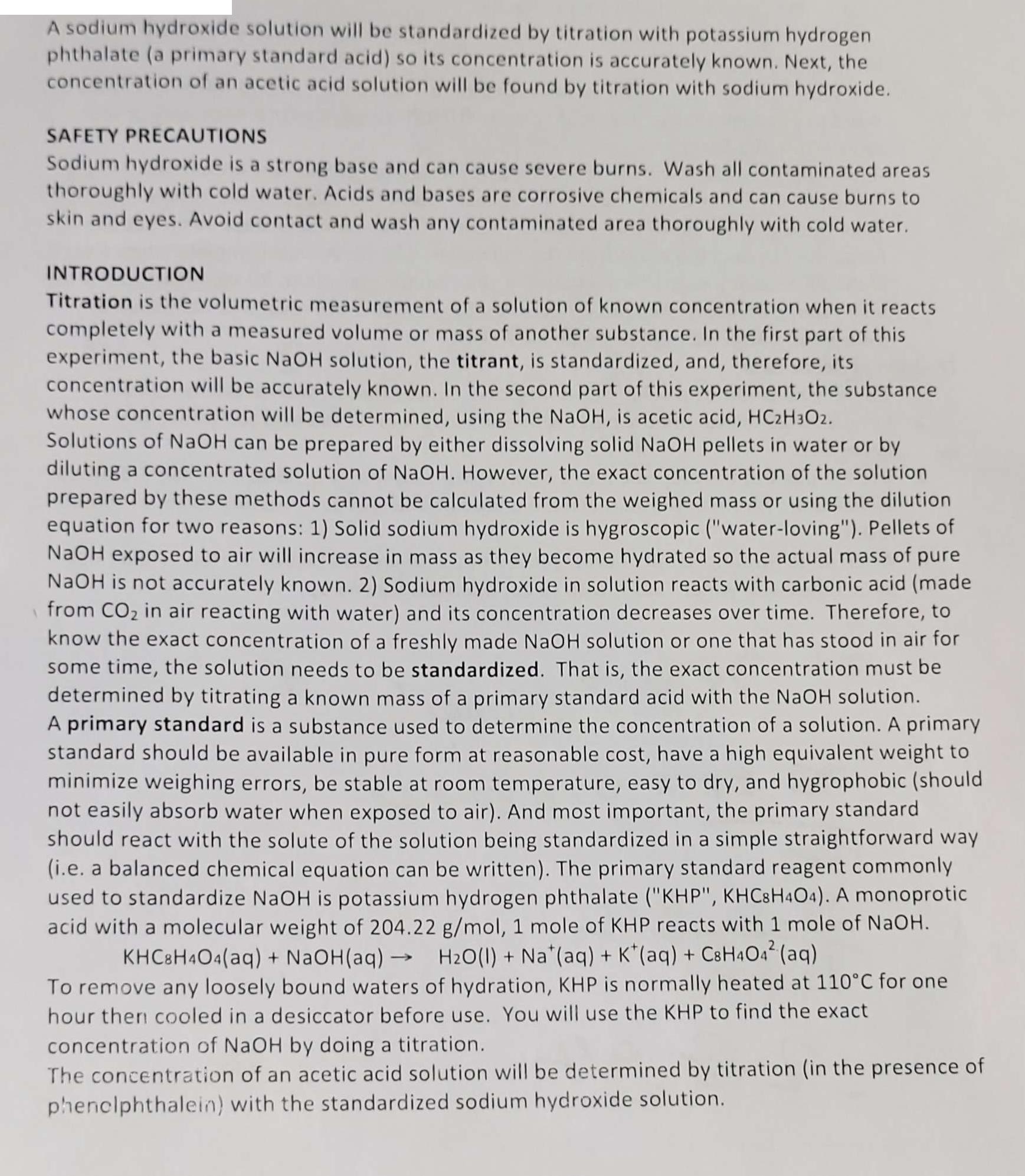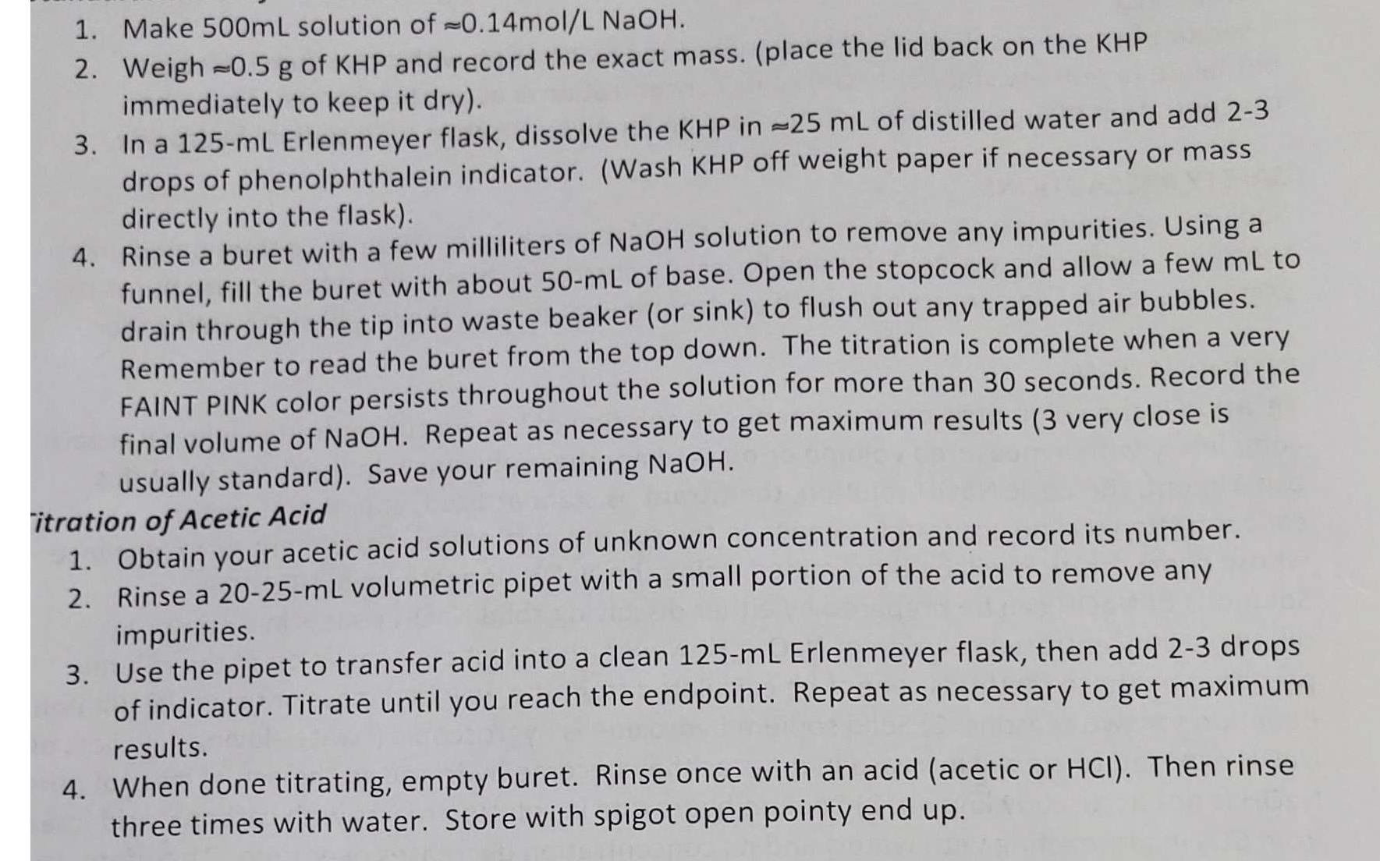Answered step by step
Verified Expert Solution
Question
1 Approved Answer
A sodium hydroxide solution will be standardized by titration with potassium hydrogen phthalate (a primary standard acid) so its concentration is accurately known. Next,


A sodium hydroxide solution will be standardized by titration with potassium hydrogen phthalate (a primary standard acid) so its concentration is accurately known. Next, the concentration of an acetic acid solution will be found by titration with sodium hydroxide. SAFETY PRECAUTIONS Sodium hydroxide is a strong base and can cause severe burns. Wash all contaminated areas thoroughly with cold water. Acids and bases are corrosive chemicals and can cause burns to skin and eyes. Avoid contact and wash any contaminated area thoroughly with cold water. INTRODUCTION Titration is the volumetric measurement of a solution of known concentration when it reacts completely with a measured volume or mass of another substance. In the first part of this experiment, the basic NaOH solution, the titrant, is standardized, and, therefore, its concentration will be accurately known. In the second part of this experiment, the substance whose concentration will be determined, using the NaOH, is acetic acid, HC2H3O2. Solutions of NaOH can be prepared by either dissolving solid NaOH pellets in water or by diluting a concentrated solution of NaOH. However, the exact concentration of the solution prepared by these methods cannot be calculated from the weighed mass or using the dilution equation for two reasons: 1) Solid sodium hydroxide is hygroscopic ("water-loving"). Pellets of NaOH exposed to air will increase in mass as they become hydrated so the actual mass of pure NaOH is not accurately known. 2) Sodium hydroxide in solution reacts with carbonic acid (made from CO2 in air reacting with water) and its concentration decreases over time. Therefore, to know the exact concentration of a freshly made NaOH solution or one that has stood in air for some time, the solution needs to be standardized. That is, the exact concentration must be determined by titrating a known mass of a primary standard acid with the NaOH solution. A primary standard is a substance used to determine the concentration of a solution. A primary standard should be available in pure form at reasonable cost, have a high equivalent weight to minimize weighing errors, be stable at room temperature, easy to dry, and hygrophobic (should not easily absorb water when exposed to air). And most important, the primary standard should react with the solute of the solution being standardized in a simple straightforward way (i.e. a balanced chemical equation can be written). The primary standard reagent commonly used to standardize NaOH is potassium hydrogen phthalate ("KHP", KHC8H404). A monoprotic acid with a molecular weight of 204.22 g/mol, 1 mole of KHP reacts with 1 mole of NaOH. KHC8H4O4(aq) + NaOH(aq) H2O(l) + Na* (aq) + K*(aq) + C8H4042 (aq) To remove any loosely bound waters of hydration, KHP is normally heated at 110C for one hour then cooled in a desiccator before use. You will use the KHP to find the exact concentration of NaOH by doing a titration. The concentration of an acetic acid solution will be determined by titration (in the presence of phenolphthalein) with the standardized sodium hydroxide solution. 1. Make 500mL solution of -0.14mol/L NaOH. 2. Weigh =0.5 g of KHP and record the exact mass. (place the lid back on the KHP immediately to keep it dry). 3. In a 125-mL Erlenmeyer flask, dissolve the KHP in -25 mL of distilled water and add 2-3 drops of phenolphthalein indicator. (Wash KHP off weight paper if necessary or mass directly into the flask). 4. Rinse a buret with a few milliliters of NaOH solution to remove any impurities. Using a funnel, fill the buret with about 50-mL of base. Open the stopcock and allow a few mL to drain through the tip into waste beaker (or sink) to flush out any trapped air bubbles. Remember to read the buret from the top down. The titration is complete when a very FAINT PINK color persists throughout the solution for more than 30 seconds. Record the final volume of NaOH. Repeat as necessary to get maximum results (3 very close is usually standard). Save your remaining NaOH. itration of Acetic Acid 1. Obtain your acetic acid solutions of unknown concentration and record its number. 2. Rinse a 20-25-mL volumetric pipet with a small portion of the acid to remove any impurities. 3. Use the pipet to transfer acid into a clean 125-mL Erlenmeyer flask, then add 2-3 drops of indicator. Titrate until you reach the endpoint. Repeat as necessary to get maximum results. 4. When done titrating, empty buret. Rinse once with an acid (acetic or HCI). Then rinse three times with water. Store with spigot open pointy end up.
Step by Step Solution
There are 3 Steps involved in it
Step: 1

Get Instant Access to Expert-Tailored Solutions
See step-by-step solutions with expert insights and AI powered tools for academic success
Step: 2

Step: 3

Ace Your Homework with AI
Get the answers you need in no time with our AI-driven, step-by-step assistance
Get Started


